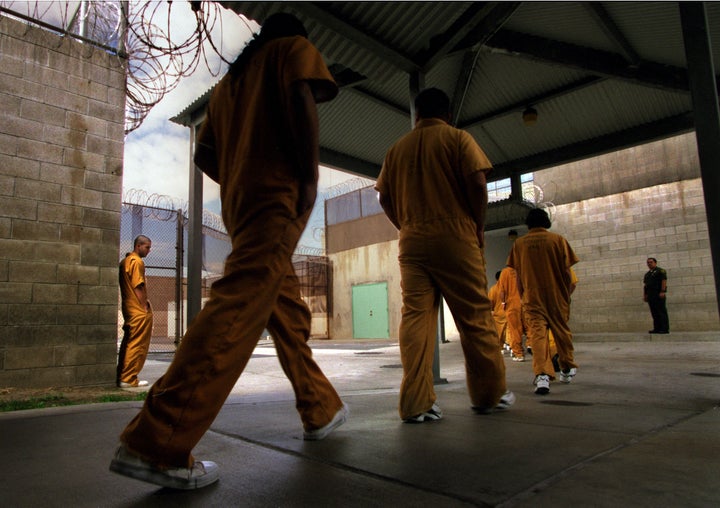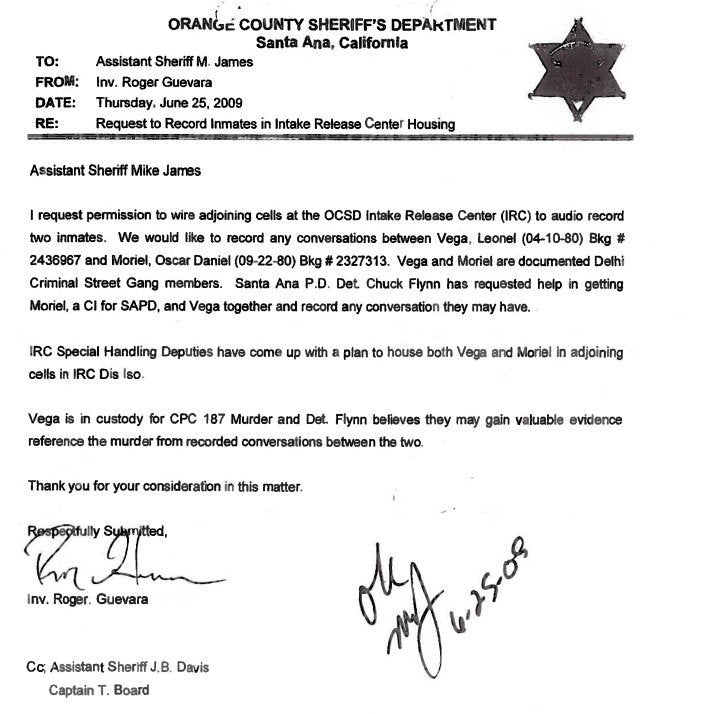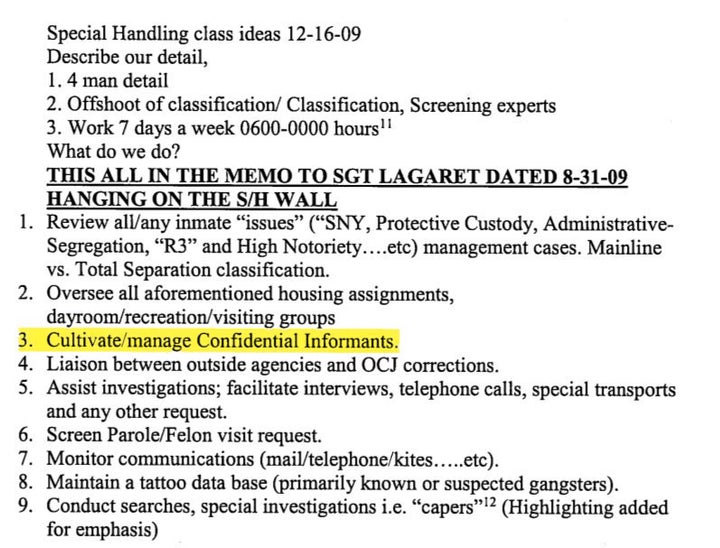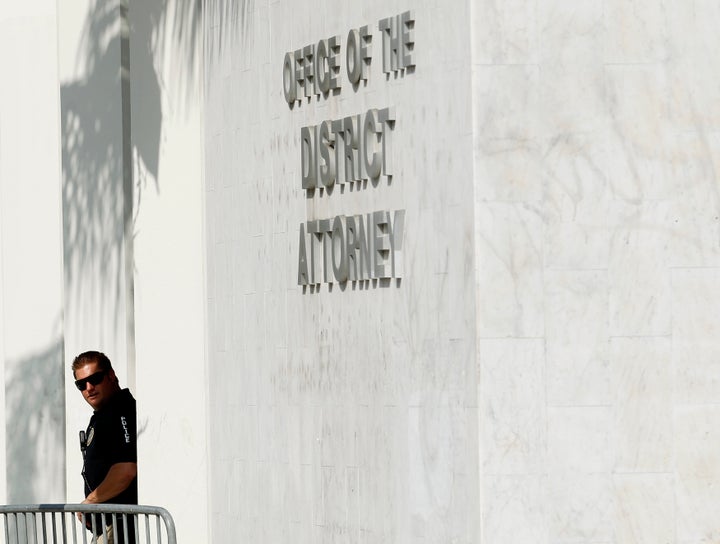LOS ANGELES ― A grand jury in California that investigated an Orange County jailhouse informant program, which a Superior Court judge and a state appeals court have agreed clearly exists, issued an unsettling report last week claiming that it is a “myth” largely created by the defense in a mass murder case and the media and that there is no widespread cheating by district attorney’s and sheriff’s officials, even though another ruling Friday in a murder case again indicated it is true.
At the center of the scandal are allegations that sheriff’s deputies have for decades planted informants next to targeted inmates in the county’s jails and have directed them to fish for incriminating evidence to help secure convictions. While it’s legal for law enforcement authorities to use informants to help bolster cases, in many Orange County trials, it’s alleged that the informants questioned inmates who were represented by lawyers, violating their right to counsel. Prosecutors are accused of presenting damning evidence gathered by the informants in court while withholding other evidence that could have been beneficial to the defense. That would violate a defendant’s right to due process.
While the Orange County grand jury conceded that there have been some violations in a “small number” of cases, it’s largely due to “laxness in supervision” at the agencies, which, the grand jury said, have moved to correct course.
The grand jury also found that ongoing hearings related to the misuse of informants inside county jails, which are being conducted as part of the penalty phase in the case against mass killer Scott Dekraai, are nothing more than a “witch hunt” that the grand jury suggested should be stopped.
Dekraai pleaded guilty to murdering eight people in a Seal Beach hair salon in 2011. He is still awaiting sentencing while the courts wrangle over allegations of malfeasance in the use of a jail informant who was allegedly planted in a cell next to Dekraai. At stake is whether the court will impose a death sentence.
The Orange County Sheriff’s Department and Orange County district attorney’s office have long denied that their officials have cheated to secure convictions. And the grand jury indicated that they should be believed.
But the grand jury’s findings fly in the face of years of litigation, a mountain of evidence and multiple court rulings.
Just Friday, an appeals court unanimously affirmed a ruling that the district attorney’s office improperly withheld records on a jailhouse informant used in the 2005 double-murder trial of Henry Rodriguez, who was freed in May 2016 after spending 18 years in prison. His attorney told the Los Angeles Times that he was never contacted by the grand jury about Rodriguez’s case.
The grand jury’s findings have left many legal experts startled and deeply concerned that there must be an outside, independent probe of the allegations, beyond the investigation by the county’s grand jury.
“I was surprised and distressed by the grand jury report,” Erwin Chemerinsky, dean of law at the University of California, Berkeley, told HuffPost.
Laura Fernandez, a senior Liman Fellow at Yale Law School who studies prosecutorial misconduct around the nation, said that “this situation calls for a genuinely independent inquiry, one that asks real questions in the hopes of getting real answers.”
Here’s some of the reasons the report left many feeling that an independent probe is desperately needed now more than ever before.

Grand jury says it’s just “rogue deputies” who worked informants improperly, despite court evidence.
While the grand jury accepts that the Orange County Sheriff’s Department may be using jailhouse informants, in its report it advances a narrative that sheriff’s supervisors gave at recent Superior Court hearings linked to the jail informant scandal. They testified that it was merely a small group of rogue deputies who were illegally working with informants that violated the rights of numerous defendants and that it was done behind the backs of their supervisors.
But that narrative disintegrated over the last two weeks of testimony as a deputy and a supervisor indicated that the department’s upper management were aware of deputies’ actions with jail informants and that deputies received supervisor approval to do that work. There’s also a stack of internal memos that have been produced in court that detail the clear understanding of widespread use of jailhouse informants all the way up the chain of command at the sheriff’s office for more than a decade.
One internal memo, dated March 2007 and sent from a sheriff’s sergeant on up to a captain, celebrates the “intelligence gathering” skills of the Special Handling unit at one county jail. It states that the jail unit “possesses an excellent expertise in the cultivation and management of informants” ― expertise “recognized by the Orange County District Attorney’s Office as well as numerous law enforcement agencies throughout Southern California.”
A 2009 internal OCSD memo sent to command staff requests permission from an assistant sheriff to place an informant next to an inmate charged with murder so the conversation can be recorded. The assistant sheriff granted permission the same day it was requested.

A 2008 memo from deputies to members of the department’s command staff indicates that nearly a decade ago the OCSD admitted it had already cultivated “hundreds of confidential informants.”
Another internal memo from 2007 details a large informant presence in the jails, saying there were “in excess of 40 [informants] throughout the facility” at the time.
There’s also an internal memo once posted on a wall in the office of the Special Handling unit, which dealt with jail informants. The memo listed deputies’ duties, including “Cultivate/manage Confidential Informants.”

Before their report was published, grand jurors heard the testimony and observed the key documents being discussed in the courtroom. Grand jurors also had access to court briefs on the internal OCSD memos and other evidence. But the report doesn’t address that testimony or evidence.
The sheriff’s department, responding to a request for comment, directed HuffPost to its statement last week on the release of the grand jury report that says it “validates many past statements made by Sheriff Sandra Hutchens regarding the use of jailhouse informants and confirms a departmentally sanctioned program does not exist.”

Report doesn’t address accusations that the D.A.’s office failed to turn over internal informant records.
The Orange County district attorney’s office maintains a database of informant records called the Orange County Informant Index, a set of records on jailhouse informants maintained by the prosecutors’ office stretching back decades. But Assistant Public Defender Scott Sanders ― Dekraai’s defense attorney, who, in a series of bombshell motions, has unearthed evidence of a long-concealed snitch program operating inside county jails ― argues that the D.A.’s office has repeatedly failed to turn over those records in various cases and has struggled with producing these records for at least two decades.
Sanders obtained a 1999 letter sent to Orange County District Attorney Tony Rackauckas from the California attorney general’s office in which David Druliner, who headed the state attorney general’s criminal division, describes his serious concern about the unwillingness of prosecutors ― including the head of Rackauckas’ homicide unit ― to turn over informant evidence favorable to a man on death row. Druliner threatened to turn the evidence over himself, which ultimately forced the district attorney’s office to comply.
The grand jury report does address the existence of an informant database and concedes that some prosecutors have used “flawed legal reasoning” when deciding not to disclose informant information from it, but the report gives little sense of the scope of the problem, it does not address the letter nor what it suggests about Rackauckas’ apparent ambivalence to determining whether other cases were affected.
Sanders told HuffPost that he sat down with the grand jury’s informant committee and its adviser, former U.S. Attorney Andrea Ordin, and raised the issue of the Rackauckas-Druliner exchange but that they appeared disinterested.
“Omitting from the report any mention of the letter and the cases in which index entries were hidden over the past three decades corroborates that the grand jury was simply never going to call it straight when it came to the D.A.’s office,” Sanders said.
Ordin did not respond to HuffPost’s requests for comment.
The D.A.’s office misconduct identified by Superior Court Judge Thomas Goethals in the Dekraai penalty phase, which led to the OCDA office being recused from the case, was affirmed last November by the state’s 4th District Court of Appeal, but that ruling is addressed in the report only as a footnote.
The D.A.’s office was also found to be attempting to steer murder cases away from Goethals, a tactic called “blanket papering.” In 55 of 58 cases over two years, county prosecutors apparently tried to avoid Goethals. Superior Court Judge Richard King said the tactic had “substantially disrupted the orderly administration of criminal justice in the county.”
“Remember here the Court of Appeal described the behavior of the OC district attorney as egregious,” Chemerinsky said. “The D.A.’s office abused its power by ‘papering’ Judge Goethals in retaliation in 55 of 58 cases over a two-year period. The D.A.’s own commission made recommendations that have been ignored. None of this is reflected in the grand jury report.”
Rackauckas has long maintained that no one in his office intentionally behaved inappropriately in relation to the jailhouse informant program and that no prosecutors have illegally withheld evidence.
The district attorney’s office did not immediately respond to a request for comment, but in response to the grand jury findings, it said last week that the report “confirms the steadfast position” of the district attorney’s office and that the grand jury “debunked the media ‘witch hunt’ for agency corruption.”

Would an illegally operated informant program have “job descriptions” and “calendaring of events”? Grand jury thinks it must.
The grand jury strongly condemned the claims of what it called a “structured jailhouse informant program” operating in the Orange County jails and argued that allegations that the district attorney’s office and sheriff’s department conspired to violate inmates’ rights through the use of such a program are “unfounded.”
“That narrative does not stand up to factual validation,” the report reads. The grand jury says it found no evidence of a “strategic plan” or “schedule” for jail snitches, no “formal training,” “dedicated budget,” “codified job descriptions” or “calendaring of events” for a jailhouse informant program.
Legal experts were puzzled by this insistence that a shadow program in county jails wouldn’t exist without having a formal organization.
“Noting the absence of ‘definitive’ evidence of a ‘structured’ jailhouse informant program, the grand jury simply dismissed outright the possibility of something more covert and loosely organized than what it allegedly set out to find,” Fernandez, the Yale fellow, told HuffPost. The grand jury, Fernandez argued, never stopped to consider “whether evidence of ‘strategic plans,’ ‘dedicated budgets’ and ‘calendared events’ was something one might really hope to find in the context of an (illegal) informant program.”
Moreover, the grand jury does not explain why it has focused on determining whether a formally structured informant program existed instead of analyzing case by case how fair trials may have been affected by jail informant evidence.
For instance, court records indicate that one section of the jail, called L-20, which was officially designated a mental health ward but has recently come to be understood as an “informant tank,” appears to have been used for years to obtain evidence in violation of defendants’ rights. The use of informant tanks is not discussed in the grand jury report.
“They omitted everything that would have decimated their conclusions,” Sanders told HuffPost. “For instance, before the ‘rogue’ deputies did their work, supervisors bragged about the cultivation of hundreds of jail informants done by different deputies. Would those deputies qualify as ‘rogue,’ too, even as their bosses gloated about the informant work they orchestrated? This group ... showed not the slightest sign they were concerned about all the evidence kept from indigent defendants.”
Grand jury may have overstepped its authority in suggesting Dekraai hearings should end.
The grand jury’s report implies that Judge Goethals should cease the ongoing evidentiary hearings in the Dekraai case.
“Any further investigation of potential widespread, systemic institutional wrongdoing surrounding discovery or informant issues in Orange County would be far more appropriately addressed by these agencies and not by the trial court for the largest confessed mass murderer in Orange County history,” the report reads.
While a grand jury has broad authority granted by statute to investigate matters of local, city or county concern, it does not have the authority to investigate matters of state concern. Superior Courts are considered state courts.
So, questioning an ongoing hearing conducted by a Superior Court judge appears to fall outside its mission.
The grand jury report must be authorized by the Superior Court, but the court does have the right to refuse the filing if the report “exceeds established legal limits,” according to state statute. The courts are not bound to act upon the grand jury report other than to be informed by it.
The public information officer for the Orange County Superior Court system, under which the grand jury falls, told HuffPost in a statement that the Superior Court signed off on the grand jury report before it was published and posted but that the presiding judge can reject a report if it exceeds the grand jury’s authority. When asked if the court believed the grand jury may have exceeded its authority, the office said it could not provide insight “into the judicial decision-making process.”

Report’s tone breeds skepticism.
The tone of the report, which is dismissive of the years-long efforts by multiple lawyers and judges in the county, has also raised questions about its fairness, particularly with information coming to light that the grand jurors met with dozens of prosecutors but few defense attorneys.
The jail informant program is a “myth,” the grand jury declared. Current investigations of the sheriff’s department and prosecutors are a “witch hunt,” it said. And even when the grand jury argued that just a few deputies might have illegally used jail informants, the deputies were presented as having somewhat noble intensions, that they had gotten “carried away with efforts to be crime-fighters.”
“Once I saw them describe the investigation as a ‘witch hunt,’ I was very skeptical of the report,” Chemerinsky said.
Fernandez said that the grand jury opting to use such incendiary language was disturbing because it flies in the face of “contrary, carefully reasoned findings by the two courts who have considered the question the most closely.”
“That language, like the report’s broader findings, has left everyone familiar with the situation scratching their heads ― including, unfortunately, some of the victims,” Fernandez said.
Fernandez referred to the reaction of Paul Wilson, whose wife, Christy, was one of the eight people killed by Dekraai. “A myth? What a slap in the face to each of these families,” Wilson said to the court. “We have had to suffer through this, and they call it a myth.”
The Orange County allegations have prompted the U.S. Department of Justice to launch an investigation.
